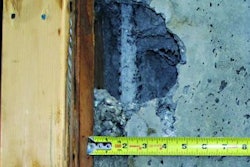WASHINGTON (AP) - For homebuilders, it hardly feels like an economic recovery.
Nearly two years after the recession ended, the pace of construction is inching along at less than half the level considered healthy. Single-family home building, the bulk of the market, has dropped 11 percent in that time. And there's no sign it will improve soon.
Builders are struggling to compete with waves of foreclosures that have forced down prices for previously occupied homes. The weakness is weighing on the economy.
Though new homes represent a small portion of overall sales, they have an outsize impact on the economy. Fewer new homes mean fewer jobs.
Skip Howes, a homebuilder in Woodland Park, Colo., has managed to stay in business only after laying off two workers in the past few years. He's now running a two-man operation in the small town outside of Colorado Springs. The other man is his son.
But business isn't picking up. Before the housing boom, he built as many as six homes a year. Last year, he built only one. This year, he's had no home projects.
"We've been holding on for years," Howes said. "If I can't diversify, and if things don't improve, I might have to lay off my son."
The Commerce Department said Tuesday that new-home construction plummeted last month to a seasonally adjusted rate of 523,000 homes a year. A big drop in volatile apartment-building construction pulled down the monthly figures. Tornadoes and flooding also disrupted construction projects throughout the South.
If the pace doesn't improve, this year could end up with fewer new homes than last year and only slightly more than 2009 - the two worst years on records dating back a half-century. Those two years benefited from a temporary home-buying tax credit.
Tuesday's disappointing construction data contributed to a sell-off on Wall Street. The Dow Jones industrial average fell by more than 150 points before recovering more half of its losses to end the day down 68 points. Nearly every major homebuilder stock dropped.
Stocks also traded lower after Hewlett Packard downgraded its earnings outlook for the rest of the year, and the Federal Reserve said temporary parts shortages out of Japan led to the first decline in factory output in 10 months.
Higher commodity prices have increased the cost of nearly every building material, from lumber to roofing tiles to windows.
The nation's largest homebuilders - including PulteGroup, Lennar, D.R. Horton and KB Home - have deeper pockets. So they have survived the turbulent stretch by cutting prices and offering more incentives.
Small and mid-sized homebuilders haven't been as fortunate. Many small builders are staying in business either by working on a few choice properties or focusing on remodeling and renovation projects.
"Everybody is feeling the pinch," said Greg Ugalde, a midsize homebuilder in Torrington, Conn., who is building a third of the homes he built in years before 2003, when the housing boom began.
High unemployment and stricter lending requirement have greatly reduced the number of potential buyers who could qualify for a mortgage. And those who are eligible have more incentive to buy a previously occupied home.
Millions of foreclosures and short sales - when the lender agrees to accept less than what is owed on the mortgage - have lowered prices for existing homes. The median price of a new home was about 34 percent higher in March than the median price for a re-sale. That's more than twice the markup in healthy housing markets.
In some cities, prices are half of what they were before the housing market collapsed in 2006 and 2007. Many potential buyers who could qualify for loans are worried that prices will fall further. Others are hesitant to put their own homes on the market when prices are dropping.
"There are very few signs of recovery in residential construction," said Celia Chen, senior director at Moody's Analytics. "Absent evidence of stronger demand for housing, homebuilders will remain reticent to put up new homes."
Single-family home construction, which represents 80 percent of the housing market, has helped lead the country out of past recessions. Each new home built creates an average of three jobs for a year and generates about $90,000 in taxes, according to the National Association of Home Builders.
After the six economic downturns between 1960 and 2001, construction jumped an average of 35 percent in the first 22 months, according to Credit Suisse Securities.
But that hasn't been the case since the Great Recession ended in June 2009. Single-family building actually fell 11 percent in that time.
Some factors are unpredictable. Violent tornados and flooding along the Mississippi River contributed to a 23 percent drop in building throughout the South, analysts said. Reconstruction efforts might lead to a "bounce back in May," according to Paul Dales, senior U.S. economist at Capital Economics.
Home Depot and Lowe's Cos, the nation's biggest home improvement retailers, both blamed bad weather when reporting lower revenue for the February-April quarter. The worsening housing market and higher gas prices also cut into their sales.
Home construction activity was uneven last month across the rest of the country. It fell nearly 5 percent in the Northeast but rose almost 4 percent in the West and nearly 16 percent in the Midwest.
Most builders say they don't expect a housing recovery until they see fewer homes in foreclosure and looser credit requirements. In the meantime, Howes, the Colorado homebuilder, said he's broadened his services to include painting, kitchen remodeling and other home improvements to stay in business. Many others are doing the same.
"We need to diversify in order to survive," Howes said. "It's not like it used to be and we need to try new things."
Copyright 2011 The Associated Press.



















